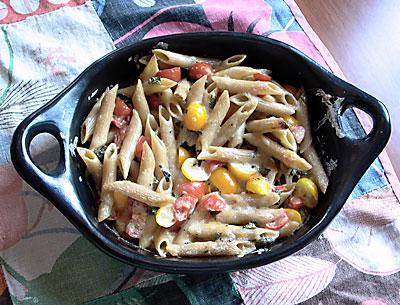Seasons by the Sea: Warm Food, Warm Relations

It’s that time of year . . . kind of. One day it’s 70 degrees, next day it’s 42. This puts me in the mood for casseroles. Hearty or light, rich or delicate, it’s a good time to utilize the end-of-season corn and tomatoes and incorporate them into whatever kind of casserole, stew, or chili you like.
It could be a rich, cheesy penne dish like one from the famous Al Forno restaurant in Providence, R.I., or the light and spicy chicken chili recipe that I wrestled from my good friend Beverly Kazickas.
If you are going to stew or braise something on top of the stove or bake it in the oven it is essential that you have the right piece of equipment. That would be the Dutch oven, a heavy cast iron vessel coated in enamel that can go from stove to oven to under the broiler to refrigerator. If you are going to assemble a casserole and simply bake it, then a glass Pyrex dish or ovenproof ceramic dish is fine. But Dutch ovens have lids to hold the heat and preserve the moisture of the dish, so that’s another reason you should have one. Plus, they’re better looking than a glass Pyrex dish when you bring them to the table to serve.
Cooking vessels for casseroles and stews have been around for centuries. In the late 17th century the Dutch were producing these molds with dry sand over cast iron to create a smooth, heatproof surface. In 1704, an Englishman named Abraham Darby traveled to the Netherlands to study their process, then returned home and produced and patented his own version which then made its way to the American colonies. Because the Dutch ovens could be used for anything from boiling to baking to stewing, roasting, and frying, they were a treasured piece of equipment. In fact, they were so treasured and durable they would be passed from generation to generation, as they were in Mary Ball Washington’s (George’s mum) will to her two grandchildren.
Similar cooking pots existed in other cultures — the bedourie of Australia and potjie of South Africa. In Japan the pot is known as nabemono, “nabe” meaning pot and “mono” meaning things or stuff. Nabe kakomu means “sitting around the pot.” The Japanese believe that sharing nabemono will create warm relations between the diners who eat together from the pot.
A casserole, from the French word for saucepan, can be anything from a ragout to hotpot, cassoulet, tagine, moussaka, lasagna, shepherd’s pie, gratin, rice timballo, or carbonnade. The general difference between a stew and casserole is a stew is cooked on top of the stove, a casserole baked in the oven.
For a while casseroles were a popular potluck dish, usually something smothered in canned cream of mushroom soup such as green bean casserole, topped with canned fried onions, and tuna noodle casserole. These dishes remain popular in the Midwest and are called “hotdish.”
So adopt the Japanese philosophy, make a cozy fall casserole or ragout or chili and create warm relations among family and friends dining together around a shared pot.
Click for Recipes
